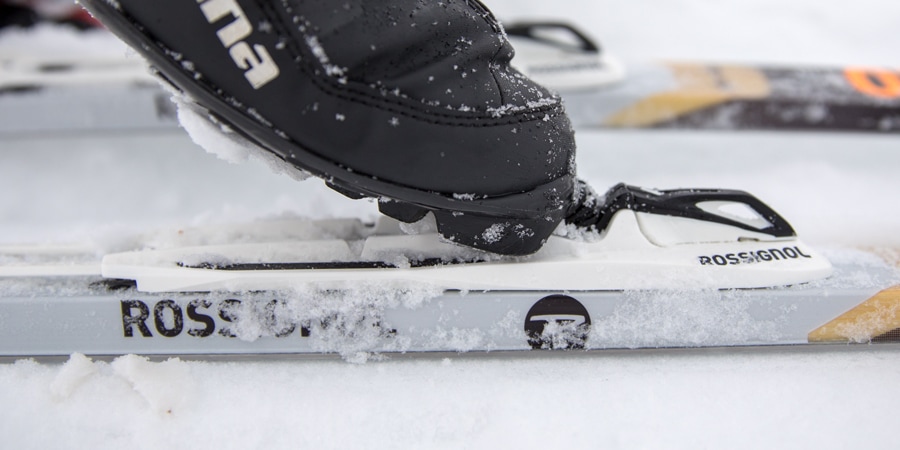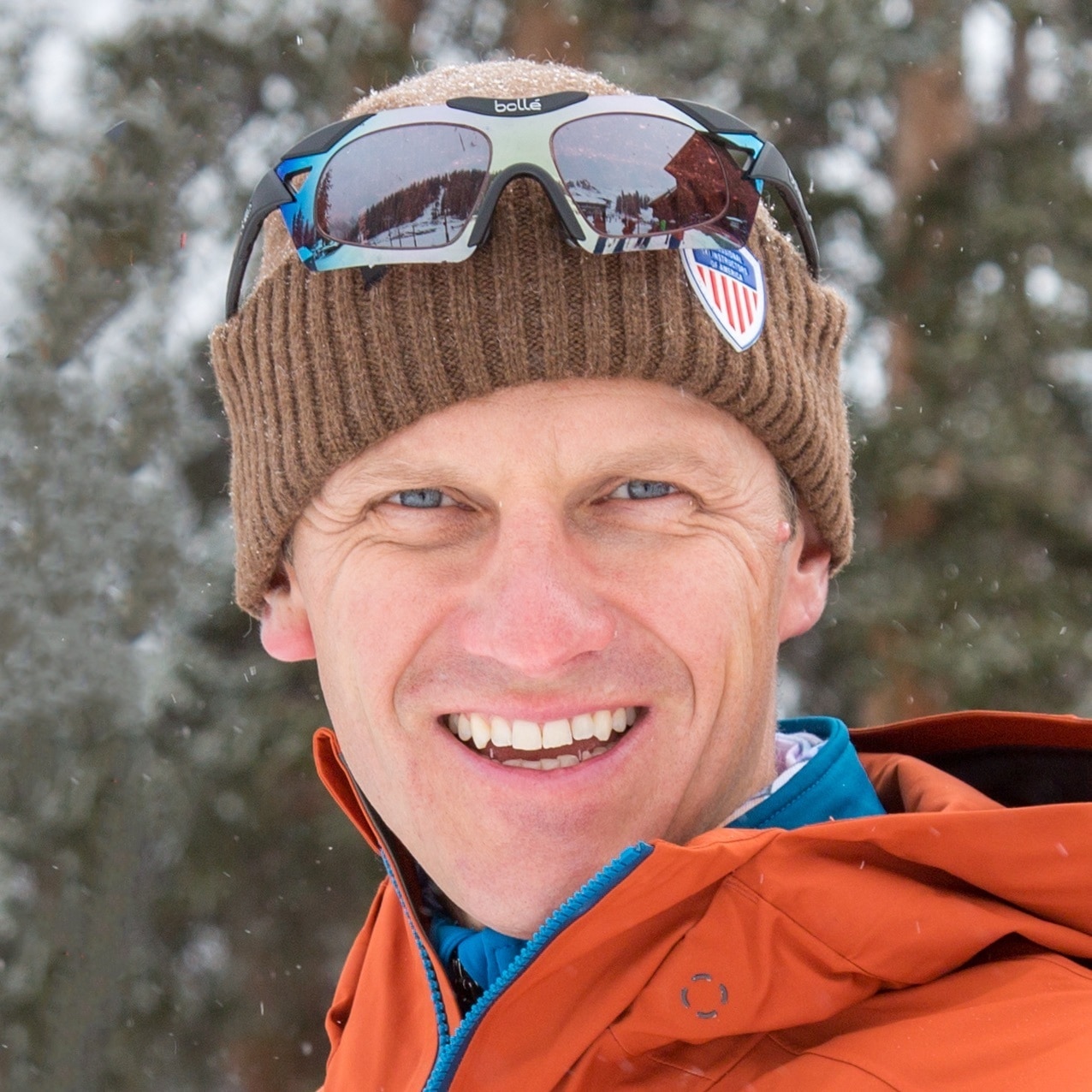Other than sledding, few winter activities are as accessible as cross-country skiing (aka Nordic or XC skiing). The sport attracts a wide cross-section of people, including hikers looking for a way to get outdoors in the winter, snowshoers who want to move more smoothly through the landscape and downhill skiers looking for a more serene (and affordable) alternative. Regardless of where you come from, with a few simple techniques you can be kicking and gliding in no time.
This article and video explain the basics of how to do classic cross-country skiing:
- Getting to know your gear
- Getting into a balanced stance
- Moving with skis on
- Using poles
- Going uphill
- Going downhill
- Turning
- Getting up after you fall
Note that this article covers classic cross-country skiing (where skis move straight), which differs from its speedier ice-skating-inspired cousin, skate skiing. Read How to Skate Ski if you want to learn the basics for that form of the sport.
Where to go to learn: This is already determined for you if you take a lesson (a great idea). If you go on your own, try to find a Nordic recreation area or resort that has groomed cross-country trails. Be sure you follow the area's etiquette rules—a universal no-no is tromping on (ruining) any ski tracks or smooth trail surfaces.
Any flat, snow-covered open space can work—city parks and golf courses that allow or promote the activity are two good options. (Avoid terrain that presents an avalanche risk.)
Getting to Know Your Gear

Most ski gear for beginners will be similar to the description below. Yours might differ, though, so make sure your gear provider shows you how everything works before you begin your first cross-country ski session.
- Find the grip zone: Flip over your skis and you'll notice a patterned area underneath the bindings. This grip zone (aka kick zone) helps you stick to the snow when you power yourself forward. The natural flex of the ski keeps this zone off of the ground when you want to glide.
- Look closely at the boots and bindings: Flip your skis upright and you'll notice a crosswise groove at the front of the binding, which mates with a skinny bar at the toe of your ski boots. Pressing your toe bar into that groove clicks you into the skis. Release mechanisms vary—pushing on a button at the front of the binding, or perhaps twisting a knob—frees your boot from the binding.
- Click in and out a few times: Stand in a flat area with skis parallel, then click your boots into and out of the bindings a few times to get the hang of how things work.
The Balanced Stance
Cross-country skiing is simple enough that you can probably shamble off awkwardly right away. Spending time on mastering balance, though, will pay big dividends. A comfortable athletic stance is the key to good balance.
Basic Athletic Body Position
- Stand upright but relaxed, with feet shoulder width apart.
- Bend softly at your ankles and knees, and stand so that your hips are right over your feet.
- Stand with your hands slightly out in front of you.
- Bounce your torso up and down slightly, focusing on feeling pressure underneath the balls of your feet.
Balance on One Foot
Cross-country skiing involves continually shifting weight from one leg to the other, and maintaining balance as you do so:
- Start out in the same balanced stance you just learned.
- Shift your weight over to one foot, swinging the opposite foot backward and opposite arm forward to counterbalance one another.
- Focus on being "stacked and stable" atop that foot: Your toe, knee and hip should all be vertically aligned as you balance on the ball of that foot.
- Shift your weight to the other foot, maintaining alignment and balance the same way you did when standing on the first foot.
- Repeat this process a few times.
Moving with Skis On
Now you'll take some of the basic movements you learned and repeat them with skis on (but without using poles).
Do the ShuffleHaving long skinny skis on your feet takes some getting used to, so click into your skis and practice shuffling gently down the trail to get a feel for how they move on the snow. It feels a little like you're simply walking on the snow.
Shuffle and GlideGliding is the motion that distinguishes cross-country skiing from hiking and snowshoeing. It's also a big part of the fun. This drill takes a basic shuffle and adds a gliding motion to the mix:
- Start by doing the easy shuffle you just learned.
- After two shuffles, quickly transfer and center your weight onto the front ski, but this time glide on it for a short distance.
- Keep repeating these steps with a shuffle, shuffle, glide cadence: You're now doing the basic kick-and-glide motion of classic cross-country skiing.
Using Poles
Used correctly, poles will increase your power—never plant them in front of you to slow yourself down, though, because this can damage them (or you). The drills below will help you learn the proper way to hold, plant and push off with your poles:
Grasp Your Poles Correctly
When the straps on your poles are looped under your wrists, you're able to use your poles efficiently—without having to keep them in a constant death grip. Grasp your poles this way:
- Slide your hand up through the strap loop from the bottom of the loop.
- Grasp the top of the strap and pole grip together (holding the strap against the grip).
- If you're able to grasp the pole well below the top of the pole, then you need to tighten the strap. (When the strap is sized correctly, the top of your hand is even with where the strap comes out of the pole.)
Basic Pole Movement
Now it's time to add a poling motion, which adds a little speed and power as you ski:
- Starting out in your balanced stance, hold your hands (with poles dangling straight down) at shoulder width out in front of you. The tops of your hands should be roughly level with your mouth, and your elbows should be bent at about 90°.
- Activate your core muscles as you move your pole tips straight down into the snow.
- Lift your poles back up to the original position and repeat. This is the basic poling motion of cross-country skiing.
The Diagonal Stride
Here's where you combine your shuffle and glide with a poling motion:
- Begin by doing the basic shuffle and glide on your skis.
- Next, add the poling motion you just learned, but use each pole individually (rather than both poles together).
- Push backward off of the tip of the pole opposite your striding leg. The hand holding the top of that pole should move in an arc that ends next to your front pants pocket.
- Do the same thing with the opposite ski and pole, pushing backward off of the pole tip to help propel the stride.
Tip: The motion of the basic diagonal stride is always opposite arm/opposite leg. (The poling arm and the opposite striding leg should move in unison.)
Diagonal stride variations: Once you get the hang of it, you can do the classic diagonal stride mile after mile. You can also experiment with different cadences: two quick strides, followed by a long glide, for example. Long glides help conserve energy. Short, quick strides help you ski up gentle hills or sprint short distances.
How to Go Uphill
Though you should start out in flat areas when you're first learning, eventually you'll want to go up a hill. Listed below, roughly in the order they might be utilized, are four options for going uphill in classic cross-country skiing:
Diagonal Stride
On gentle hills, you can use your diagonal stride to maintain momentum On steeper hills, get out of the tracks first because you might have to switch to a herringbone technique:
- Shorten and quicken your stride.
- As the hill gets steeper, your motion becomes more like a series of quick steps up the hill.
Tip: Make sure you step down hard on your ski with each stride because that helps press the ski's center grip zone more firmly into the snow.
Herringbone
Named for the pattern your skis leave in the snow, this is the go-to technique for steeper hills. Practice the herringbone first on flat terrain to get a feel for the movement:
- Step out of the tracks and move to the center section of the ski trail. (This helps keep the tracks undisturbed for other skiers who need to use them.)
- Create a "V" with your skis. (The wide part should face forward.)
- Roll your feet slightly inward, which digs the inside of the ski edges into the snow.
- Take small steps, maintaining the V shape and inward ski edge as you do. Take care not to cross the ski tails as you lift each ski up, over and in front of the tail of the other ski.
- Move using the same opposite arm/opposite leg pattern as you use in a diagonal stride; Pole tips should be placed in the snow slightly behind your skis to help keep you from sliding backward.
- Keep taking small deliberate V-steps up the hill.
Tip: The steeper the hill, the wider the V (which also helps dig the inner ski edges in more).
Side-Stepping
Slower than herringbone climbing, this method also works on steep hills:
- Move to the center of the ski trail and turn your skis sideways to the hill. (Keep skis close together and parallel at all times.)
- Tilt ski edges inward toward the slope—lean lower legs (rather than your butt or shoulders) into the slope.
- Push off of the downhill ski and take a small side-step with the uphill ski.
- Transfer weight onto the uphill ski and lift the downhill ski up, placing it next to the uphill ski again.
- Repeat until you reach the top of the hill.
Take off your skis and walk: As a last (but effective) resort, you can simply remove your skis and trudge up the hill in your ski boots—move to the outer edge of the ski trail when you do so, however, so you don't chew up the groomed surface and ski tracks.
How to Go Downhill
Hilly terrain, of course, also involves going down, something that makes many beginners anxious. Note that poles aren't used on downhills—hold them so that the pole tips are off the snow and behind your skis. Classic cross-country skiers have two basic ways to go downhill:
Gliding Down
On gentle slopes, you can stay in the ski tracks and let gravity do the work:
- Crouch down into your basic balanced ski stance: Bend softly at your ankles and knees, while also keeping your hands slightly out in front (and pole tips above the snow behind you).
- Slide smoothly down the hill.
Half-Wedge Braking
This method works well when you require just a little bit of braking help:
- Lift your inner ski up out of the track, shifting your weight so that you are balanced atop the remaining ski in the outer track.
- Angle your raised ski toward the track ski and set it down on the snow, angling its edge slightly toward you as you do so.
- Shift some weight onto your angled ski to help slow your down; you can shift more weight to it if you need more braking power.
- When you no longer need to slow down, lift the braking ski up and place it back in its original track.
Wedge Braking
Also called a triangle or a pizza, this is the same technique that beginning alpine skiers use. The full wedge provides more braking power than the half wedge, and it is done entirely out of the ski tracks:
- As soon as you crest the top of the hill, move out of the tracks to the center of the ski trail.
- Make a wedge with your skis angling your heels out and your toes and ski tips toward one another.
- Push on inside edges of your feet, which leans in your inner ski edges.
- Maintain equal pressure on the inside edge of both skis so that you'll be braking evenly.
- To increase braking power, push harder on the inside edge of your skis and move your skis into a wider wedge.
Tip: Experiment with the width of the wedge—a narrower wedge lets you accelerate, a wider one slows you down more.
How to Turn
In a groomed trail system you can turn the same way a locomotive does—by simply staying in the tracks and letting them do the turning for you. To turn your classic country skis when you're not in the tracks, use one of the following methods:
Step Turn
This turning technique lets you make a gradual turn on flat terrain or gentle hills where there are no ski tracks or you elect to get out of the ski tracks:
- Slow down and shorten up your diagonal stride.
- As you slow, lift your inside ski up and angle it slightly in the direction of the turn.
- Set down the angled ski and glide on it.
- Lift up the opposite ski and set it down parallel to the angled ski to glide on it.
- Repeat this sequence (inside foot, skis parallel, inside foot, skis parallel) until both your skis are gliding in the direction you want to go.
Tip: On a sharp turn, use short, quick strides to change your direction more quickly.
Wedge Turn
The wedge to turn is a technique alpine skiers also employ. As a cross-country skier, you use it when you need to control speed and change direction at the same time. Before you start a wedge turn, move out of the ski tracks:
- While going downhill and using your wedge to brake, rotate your legs and skis slightly in the direction you want to go, maintaining the wedge shape as you do so.
- Put slightly more weight on the outside, which helps steer you inward and around the curve.
- When you're facing the direction you want to go, maintain wedge braking (if you still need to reduce speed) or straighten your skis out to resume easy gliding again.
How to Get Up After a Fall
Falling is an inevitability in cross-country skiers: Even Olympic athletes do it from time to time. Any way you get up safely is fine, but the "dead bug" method described below can make the process a little easier:
- Take a deep breath and relax.
- Roll onto your back, while sticking your feet/skis and arms/poles up in the air (the dead bug position).
- Move your skis so that they are parallel to one another; also move your arms so that your poles aren't tangled together.
- Slowly roll over onto your side toward your parallel skis.
- Lean forward toward your hands and knees.
- From here, you should be able to stand up slowly.
Take your skis off: If you're struggling to right yourself, you can always unclip your skis from the bindings. Then you can gather your gear, stand up and move to the side of the trail, where you can put yourself back together again.
Snowsport safety is your responsibility. Be sure to use proper technique and take steps to minimize risk whenever you go.


